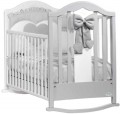Rocking mechanism
The type of mechanism that provides rocking of the crib (if any — many models
do not provide rocking).
—
Skids. Such cribs are equipped with curved skids, similar to those used in rocking chairs. Standing on such skids, the crib is capable of rocking. If such a crib is equipped with wheels, they are made removable — usually the crib stands on the skids, and the wheels are installed when it needs to be moved or fixed to prevent it from rocking.
Skids are the simplest and most reliable, but they also have their disadvantages: the baby turning in his sleep, will rock the crib, which can wake up himself; to fix the crib in a stable position, it is necessary to install wheels, which is very laborious and inconvenient. In addition, the skids are poorly combined with the floor, especially parquet and laminate, because they can damage it, and therefore put such cribs is best on carpeting.
—
Pendulum. In such models, the base is fixed on the floor, and the rest of the crib, thanks to special hinges, can rock. For a
longitudinal pendulum, the rocking goes along the crib, and for a
transverse pendulum — across. There are also
universal pendulums, the location of which is formed during assembly. Anyway, the pendulum mechanism has a lower risk of tipping if the baby
...starts to rock the bed, in addition, the pendulum, unlike the skids, does not affect the floor covering. On the other hand, the pendulum mechanism is more complicated and somewhat less reliable.Sidewalls
The type of sidewalls of the crib.
—
Slatted. They consist of vertical slats, for more details on the advantages and disadvantages of this design, refer to "Endwalls".
—
Solid. A solid surface with no recesses or holes. For more information on the advantages and disadvantages of this design, refer to "Endwalls".
—
Mesh. This wall is a frame with a mesh installed in it. It provides slightly better protection against drafts than a slatted wall; on the other hand, it is poorly suited as a support for the baby. It is used rather rarely, usually when it is difficult to install slats.
— Slatted/solid. This means that one sidewall is solid and the other is slatted. Such a crib is usually placed with a solid sidewall against the wall. Thus, parents can see the baby through the front wall, the baby can use the slats as a support for standing up, and the solid back wall protects it from drafts and contact with the wall.
— Solid/mesh. Solid walls, usually made of dense fabric, supplemented with mesh inserts. These inserts are designed to improve ventilation and to allow parents to see the baby better.
Lockable wheels
The latches are designed to
block the rotation of the wheels of the bed and prevent it from moving — for example, if a nearby baby tries to climb onto the bed or grab to stand up, the bed without latches can move, which is fraught with unpleasant consequences.
Mattress
The size of the mattress in length and width in centimeters. The standard sizes of baby mattresses are 60x120, 70x120 and 70x140; you should pay attention to these sizes if you plan to buy a mattress separately from the crib.
The length of baby cribs varies from 90 to 140 cm, with 120 cm being the most common. The smaller size means that the crib will have to be changed sooner, and the longer lengths are usually convertible cribs (refer to "Type") designed not only for babies, but also for preschoolers and schoolchildren.
The width of the mattress can vary from 40 to
70 cm, and the most common option is
60 cm, this is considered quite enough. As in the case of length, a smaller width means that the baby will become cramped in it earlier, and usually convertible models have a larger width.
All of the above does not apply to cradles (refer to "Type") — they are designed only for the smallest and are much smaller.
Distance between rails
The distance between the rails on the side or end walls of the bed. A distance of 7-9 cm is considered optimal — this is not enough for a child to crawl between the rails, but enough so that a handle or leg does not get stuck between them.

